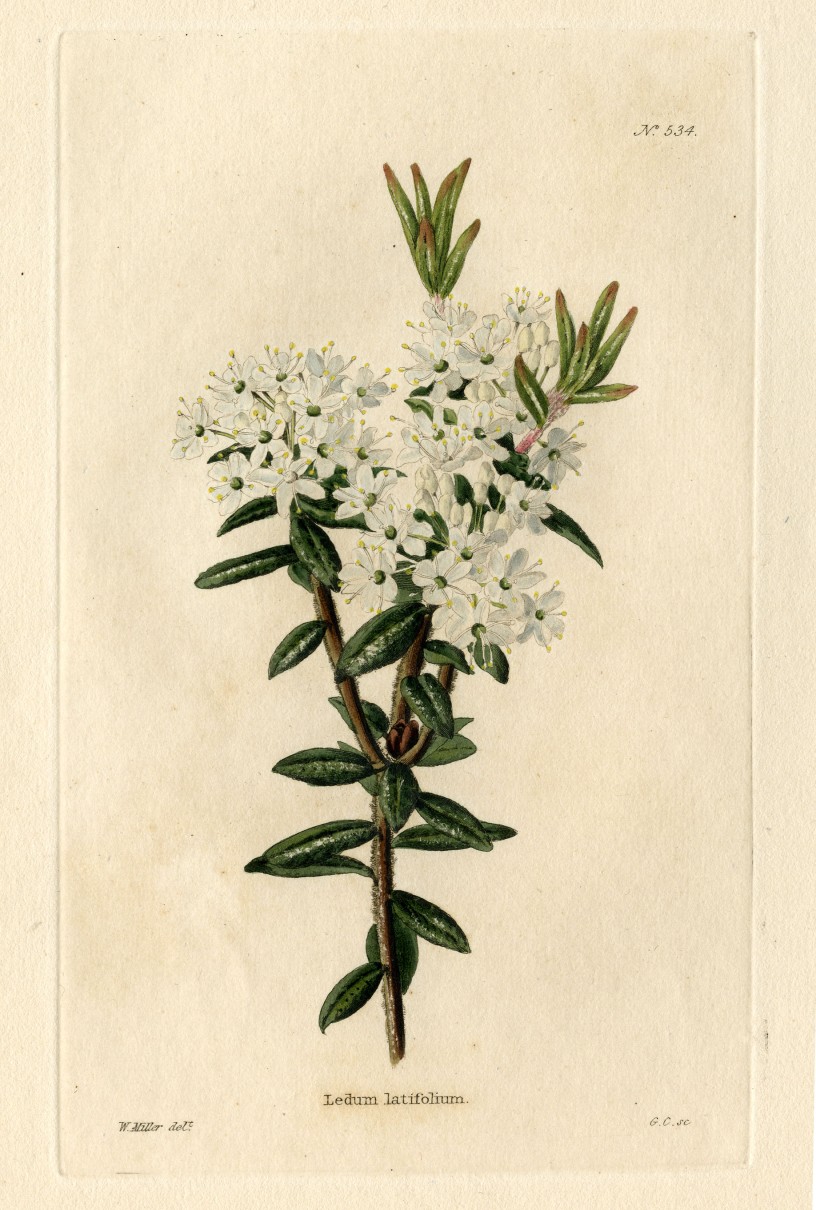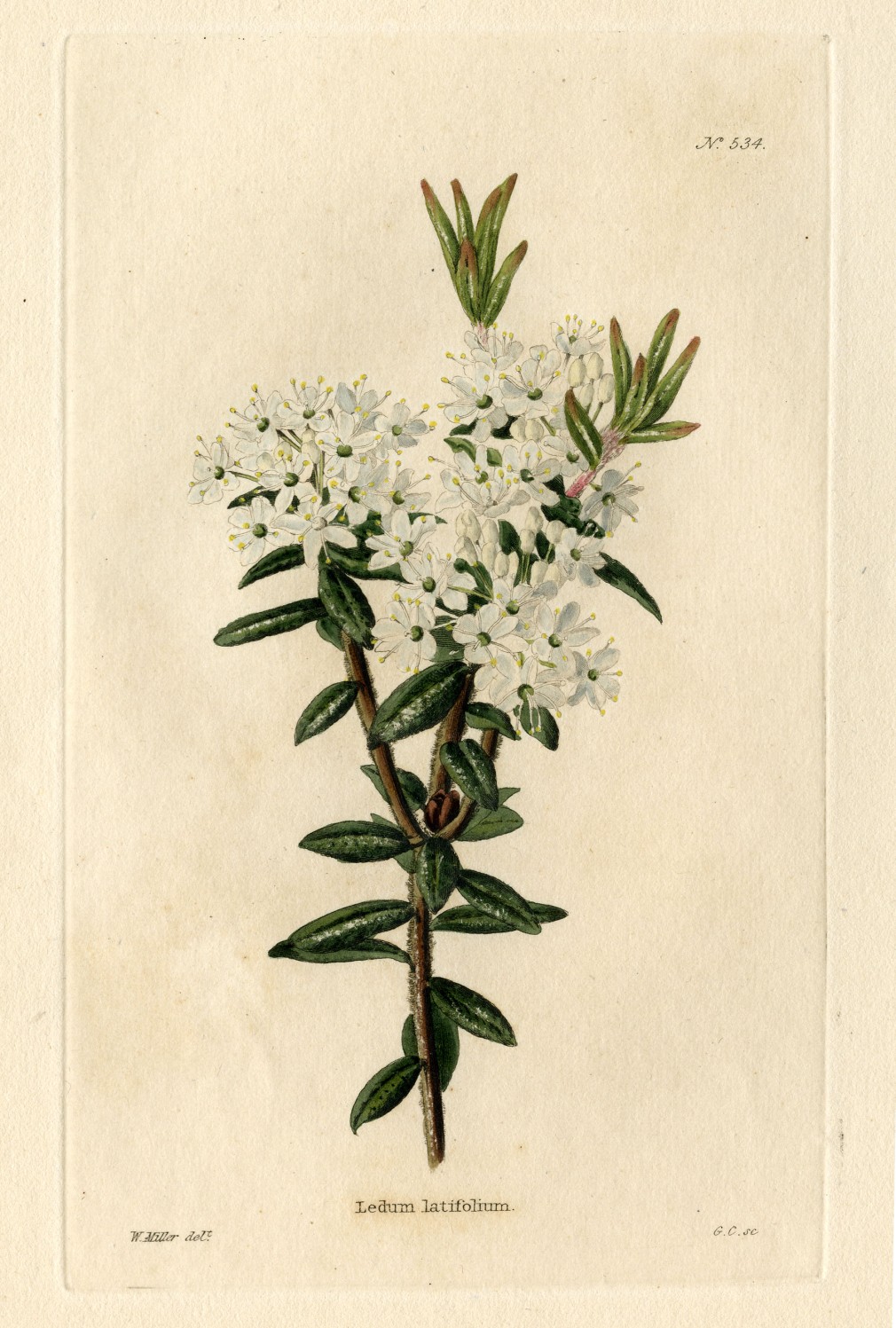
Common Name: Bog Labrador Tea
Scientific Name:
- Rhododendron Groenlandicum
- (Former) Ledum Groenlandicum
- (Former) Ledum Latifolium
Introduction:
This is a plant that is primarily used for morale purposes, either as a tea or as seasoning. Use sparingly though, as too much use can lead to a toxicity buildup. Moderate and occasional use is safe however.
Range:

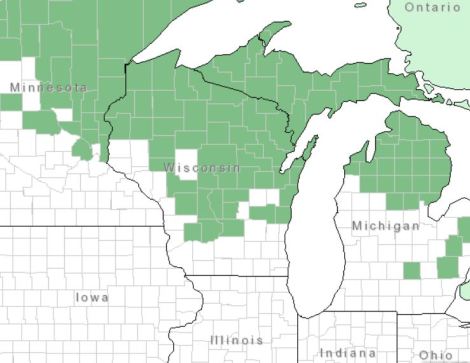
Habitat: This plant prefers to grow in damp wetlands, bogs, barrens, and peaty soils. There, especially in bogs and wet, coniferous forests, it seeks out peaty soil that is either moist or wet. Soil will tend to be acidic. It can also be found occasionally on tundra and in dry, rocky portions of mountains.
Season:
- Grows: Year-round, Evergreen, actively grows in Spring
- Flower Bloom: May-June
- Fruits: N/A
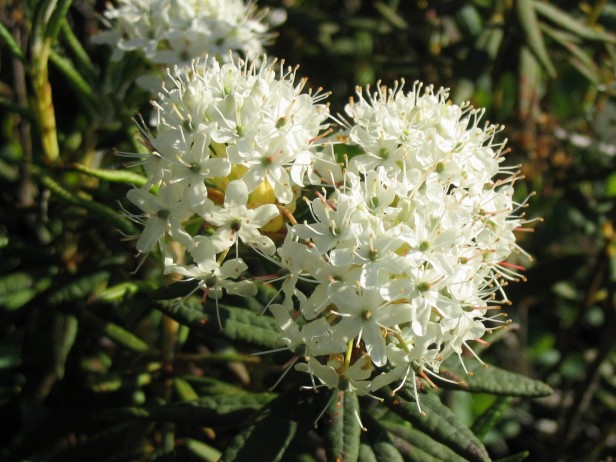
Description:
- Plant Type: Shrub, Evergreen
- Leaf Type: Non-toothed, rolled edges
- Average Height: Between 1-3 ft.
- Colors: Green Leaves with White/Rusty underside. White Flowers.
- Textures: Leaves leathery to the touch
- Flowers:
-
- Five Petals
-
- White
-
- Terminal (Grows only at the end of the stalk/sprout)
-
- Grows in clusters that stand out to the eye
- Temperature Tolerance: -33 degrees Fahrenheit
Uses:
- This plant will be primarily used as a morale booster via tea brewed from its leaves, which also provides a good source of Vitamin C.
- It has also been used by Native Americans as a Sweetener/Enrichment for Meat Spices, Soups, Sauces, Salads, Beer, and Cake.
- There has also been evidence showing that it has some medicinal qualities, although there is insufficient evidence as to how effective it is. I will not list as a matter of fact what this can be used for, as most evidence is inconclusive and at time contradictory. However, American Indians and to varying degrees amongst differing tribes have used this plant medicinally for or to treat: inflammation, asthma, rheumatism, burns, kidney disease, liver disease, blood purifier, ulcers, stomach flu, diarrhea, chills, bad breath, pneumonia, urinary difficulties, sore throats, headaches, upset stomach, heartburn/indigestion, arthritis pain, colds, and skin problems. Please look at the references below to come to your own conclusions and use at your own risk.
- Possesses a worthwhile quantity of Ascorbic Acid. When used in a tonic, this helps to improve digestion and relax stomach activity.
- It also has a worthwhile source of plant oil, which will give off a coniferous aroma.
Recipes:
- Add 1 tsp of dried leaves to 1 cup of boiling water. Steep/brew for 5 minutes. Remove leaves once steeped. Sweeten with other items to taste.
Harvesting Tips:
- Since this plant’s leaves are slow growing, harvest sparingly and from numerous plants in order to avoid killing the local population.
Dangers/Cautions:
- Do not drink more than once daily. This is due to the toxicity of the Ledol and Grayanotoxin present. Drinking too much can lead to cramps, diarrhea, cathartic issues, convulsions, vomiting, paralysis, and rarely, death.
- Do not use if nursing or pregnant. Can cause miscarriages. While the impact that using this tea can have on breast milk is unknown, due to the presence of the previously mentioned toxins, avoid using Labrador Tea while nursing as well. It is unknown just how much these toxins could be passed to the baby.
Related Species:
- Northern Labrador Tea “Rhododendron Tomentosum”
-
- Also known as Marsh Labrador Tea, Dwarf Labrador Tea, Wild Rosemary, previously as Ledum Palustre
-
- Differences:
-
-
- Shorter stature, average 0.5 to 1 foot in height
-
-
-
- Prefers slightly less acid soil and can even survive in lightly basic soil. (4.5-7.5ph)
-
-
-
- Is much more cold tolerant than its cousins, able to withstand temperatures of -62 Fahrenheit.
-
-
-
- Blooms in the summer versus the spring due to shorter seasons in the far north.
-
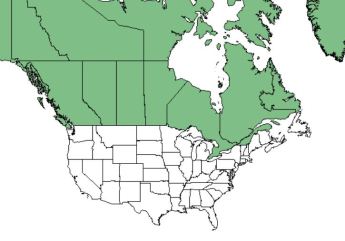

- Western Labrador Tea “Rhododendron Columbianum”
-
- Also known as Trapper’s Tea, previously as Ledum Glandulosum
-
- Differences:
-
-
- Leaves are more oval shaped.
-
-
-
- Is taller and can averages between 4 to 4.5 ft.
-
-
-
- Can exist in slightly more acidic soil
-
-
-
- Slightly less cold tolerant than its cousin (can withstand -28 Fahrenheit)
-
-
-
- Blooms earlier than its cousins
-
-
-
- Grows in a range from sea level up to 11,000 ft (3,500m).
-


Cultural Trivia:
- Used by American Indians to spice meat and for a medicinal herbal tea, focusing on helping with coughs and colds.
- The Marsh Labrador Tea variant was used to make Gruit Beer by Germans in the Middle Ages. This ceased when the determination was made that it increased aggresion.
- In Scandinavia, Marsh Labrador Tea has been utilized as a deterrent against clothes moths as well as other insects.
- It was also used a a replacement for more traditional teas during the Revolutionary War.
References:
- Edible Wild Plants; Eastern/Central North America (Peterson Field Guides) by Lee Allen Peterson, ISBN-13: 978-0-395-92622-2
- https://plants.usda.gov/java/charProfile?symbol=LEGR
- https://www.fs.fed.us/wildflowers/plant-of-the-week/ledum_groenlandicum.shtml
- https://plants.usda.gov/core/profile?symbol=LEGL
- https://plants.usda.gov/core/profile?symbol=LEPA11
- https://www.webmd.com/vitamins/ai/ingredientmono-539/labrador-tea
- https://onlinelibrary.wiley.com/doi/abs/10.1002/jsfa.6889
- http://plantwatch.naturealberta.ca/choose-your-plants/labrador-tea/
